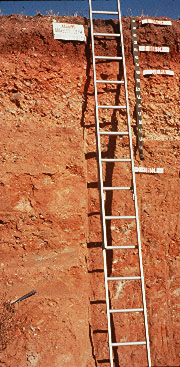 Merced Alfisol
Merced Alfisol
| Merced Alfisol | |
|---|---|
 Merced Alfisol Merced Alfisol
| Wow, this is a really thick soil. It is found in the Merced, California city sanitary landfill. The ladder indicates just how deeply weathered this alluvial parent material really is. The Central Valley is filled with sediments eroded from the Sierra Nevada, Cascade and Coast Range mountains. These sediments form alluvial fans with various age surfaces. On the older higher surfaces are found deeply weathered soils. In this case, weathering exceeds 4 meters. The profile consists of a thin A horizon, a moderately thick Bt horizon and a Bqm horizon. These horizons sit on top of more Bt and finally a C horizon somewhere below the picture. The Bt horizon is a zone of clay accumulation. Clay has been illuviated here and clay has formed in place at this level. Note the dark-reddish brown color and prismatic structure. The darker red indicates both iron and organic matter have moved downward. The lighter red indicates only iron has moved to this depth. The t denotes that clay has accumulated in this horizon. The Bqm is a cemented horizon. In this case silica (denoted by the q) is the cementing material. The m indicates cemented. Silica moved downward in solution and then was deposited as the soil dried. Over many thousands of years, the silica filled pores and cemented particles together. Because roots and water cannot pass through this horizon, it has stopped soil formation below the horizon. In part, this is why the clay content above the hardpan (another term for cemented horizon) is high. The clay cannot move beyond the cemented horizon. |
Click here to return to the index by lecture
Click here to return to the index by profile